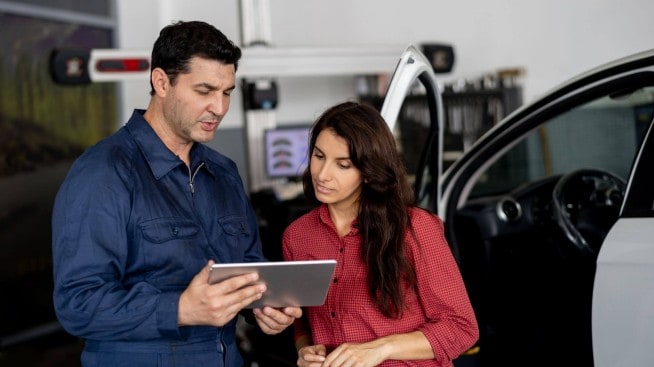What should your car maintenance schedule look like?

Quick insights
- Following your vehicle’s specific maintenance schedule can help it stay in good condition.
- Depending where you live, you may also want to consider seasonal car maintenance.
- A common car maintenance schedule is the 30-60-90 rule (where you inspect or replace certain parts every 30,000 miles).
Every vehicle will need regular maintenance—that is if you want it to run at its best and last as long as possible. And that’s why you’ll want to follow a car maintenance schedule. So, here we have some general guidelines you can follow that are common to gasoline powered cars. You’ll also want to refer to your car’s maintenance manual, for the maintenance specifics of your make and model.
Basic car maintenance schedule by mileage or time
Many car maintenance schedules follow the 30-60-90 rule—there are certain car parts you inspect or replace every 30,000 miles. If you’re driving a car with lower mileage, it’s key to consider some items that should be checked more frequently, starting at 3,000 miles.
- 3,000 miles: When you reach 3,000 miles, check your fluid levels and tire pressure. It may also be time to top off your windshield wiper fluid.
- 5,000 to 6,000 miles: In addition to checking tire pressure and fluids, inspect interior and exterior lights: brake lights, head lights, turn signals, and rotate or rebalance tires.
- 15,000 miles: If you’re typically driving in normal conditions, in addition to checking tire pressure and fluids, inspect your brake pads and replace your air filter. If you’re driving in harsher conditions, check and replace them a bit earlier.
- 30,000 miles: Reaching 30,000 is a big milestone that’ll require a bigger check-up. Check the remaining life on your tires, flush out and replace your steering fluid, flush out the cooling system and inspect all suspension components. You’ll want to check on the radiator coolant and air conditioning as well.
- 60,000 miles: Everything that is typically done at the 30,000-mile mark is examined again, but this time, additional services may be needed like replacing the timing belt and brakes.
- 90,000 miles: Similar to the 30,000- and 60,000-mile service, the 90,000-mile service includes checking your tires, replacing all necessary fluids, and checking or replacing your brakes. Spark plugs, coolant hoses, and other systems are typically inspected and replaced as needed.
There are also a few maintenance updates that should be done seasonally. Before the winter months, you may want to check your tires and switch your windshield wipers for ones that are better suited for the snow. You’ll also want to make sure your defrosting systems are working properly.
For those long summer road trips, you may want to stop at your local mechanic for an oil change or to ensure the car is ready for long drives in the heat. And don’t forget to change out your filters, including your cabin air filter, so your air conditioner can work properly!
How your driving habits impact car maintenance
Depending on your driving habits and driving conditions in your area, you may need an adjusted schedule to help keep your car in top shape. Your owner’s manual may have separate schedules for “normal” and “severe” driving conditions.
Both schedules should provide an index of car maintenance items listed by mileage.
On the normal schedule, you may discover an oil change recommended at five thousand miles, while the severe schedule recommends three thousand miles. Following are some criteria that may put you in the “severe” camp. Do you….
- Often tow or carry heavy materials? You travel with a trailer fixed to the back of your car, equipment attached to the roof or a lot of cargo in your truck. This practice decreases the vehicle's efficiency over time and may speed up wear and tear.
- Drive short distances regularly? If you’re making trips under five miles on a regular basis, this can affect your vehicle. Short trips prevent motor oil from heating up and properly lubricating the engine — have you ever heard of the term “a well-oiled machine?” If the car doesn’t heat up properly, the engine won’t run as smoothly or cleanse itself of contaminants.
- Stop-and-go in heavy traffic? If you drive in stop-and-go traffic frequently, this naturally causes your brakes to work harder. It can also affect your fluid levels and filters.
- Take on rough terrain and extreme climates? Driving in extreme climates, from snowy to dusty and dry, are considered severe climates. Road salt and moisture can wear down car parts while dirt roads can clog your filters for example.
How to decide when to repair or replace a car
Even if you maintain your vehicle perfectly, there may come a time when you wonder if you should repair or replace your car. Look at your personal circumstances and weigh the options. If you can’t purchase a new car just yet, but you can afford to make some worthwhile repairs, then repairing may be the way to go. If the repairs to your car are costly and won’t add life to your car, looking for a replacement may be your best bet.
You may want to go with repair if:
- The car is paid off and you don’t want another monthly bill.
- You were hoping to avoid replacement for a couple more years.
- It holds sentimental value.
- The cost of repair is reasonable relative to the value of the car.
But if you go with replace, you may enjoy a financial benefit:
- Sell your car to an individual or to a dealership.
- Sell it for parts.
- Donate it for a tax deduction.
The road ahead
Keeping up with a regular car maintenance schedule comes with a lot of benefits. For starters, your car should run better and last longer. You can use the above as a general guide and refer to your car manual for the specific needs of your make and model. Then, when you know your car is properly maintained, you really can sit back and enjoy the ride.



